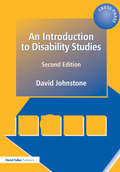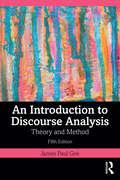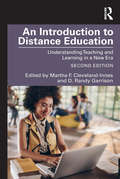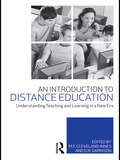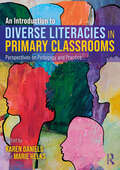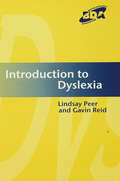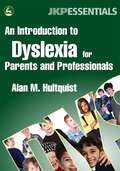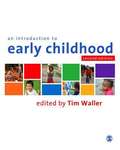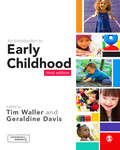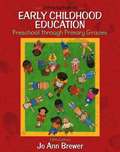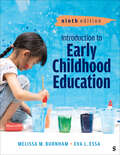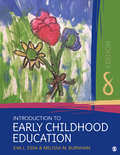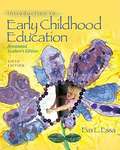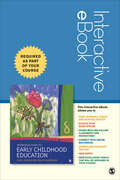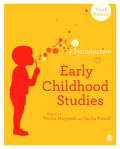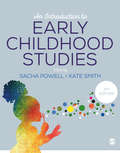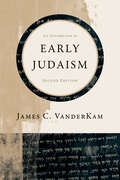- Table View
- List View
An Introduction to Data Science
by Jeffrey S. Saltz Jeffrey Morgan StantonAn Introduction to Data Science is an easy-to-read, gentle introduction for advanced undergraduate, certificate, and graduate students coming from a wide range of backgrounds into the world of data science. After introducing the basic concepts of data science, the book builds on these foundations to explain data science techniques using the R programming language and RStudio® from the ground up. Short chapters allow instructors to group concepts together for a semester course and provide students with manageable amounts of information for each concept. By taking students systematically through the R programming environment, the book takes the fear out of data science and familiarizes students with the environment so they can be successful when performing advanced functions. The authors cover statistics from a conceptual standpoint, focusing on how to use and interpret statistics, rather than the math behind the statistics. This text then demonstrates how to use data effectively and efficiently to construct models, predict outcomes, visualize data, and make decisions. Accompanying digital resources provide code and datasets for instructors and learners to perform a wide range of data science tasks.
An Introduction to Data Science
by Jeffrey S. Saltz Jeffrey Morgan StantonAn Introduction to Data Science is an easy-to-read, gentle introduction for advanced undergraduate, certificate, and graduate students coming from a wide range of backgrounds into the world of data science. After introducing the basic concepts of data science, the book builds on these foundations to explain data science techniques using the R programming language and RStudio® from the ground up. Short chapters allow instructors to group concepts together for a semester course and provide students with manageable amounts of information for each concept. By taking students systematically through the R programming environment, the book takes the fear out of data science and familiarizes students with the environment so they can be successful when performing advanced functions. The authors cover statistics from a conceptual standpoint, focusing on how to use and interpret statistics, rather than the math behind the statistics. This text then demonstrates how to use data effectively and efficiently to construct models, predict outcomes, visualize data, and make decisions. Accompanying digital resources provide code and datasets for instructors and learners to perform a wide range of data science tasks.
An Introduction to Decision Theory
by Martin PetersonThis introduction to decision theory offers comprehensive and accessible discussions of decision-making under ignorance and risk, the foundations of utility theory, the debate over subjective and objective probability, Bayesianism, causal decision theory, game theory, and social choice theory. No mathematical skills are assumed, and all concepts and results are explained in non-technical and intuitive as well as more formal ways. There are over 100 exercises with solutions, and a glossary of key terms and concepts. An emphasis on foundational aspects of normative decision theory (rather than descriptive decision theory) makes the book particularly useful for philosophy students, but it will appeal to readers in a range of disciplines including economics, psychology, political science and computer science.
An Introduction to Decision Theory
by Martin PetersonThis introduction to decision theory offers comprehensive and accessible discussions of decision-making under ignorance and risk, the foundations of utility theory, the debate over subjective and objective probability, Bayesianism, causal decision theory, game theory, and social choice theory. No mathematical skills are assumed, and all concepts and results are explained in non-technical and intuitive as well as more formal ways. There are over 100 exercises with solutions, and a glossary of key terms and concepts. An emphasis on foundational aspects of normative decision theory (rather than descriptive decision theory) makes the book particularly useful for philosophy students, but it will appeal to readers in a range of disciplines including economics, psychology, political science and computer science.
Introduction to Design Education: Theory, Research, and Practical Applications for Educators
by Steven FaermThis practical, engaging book offers design educators a comprehensive, hands-on introduction to design education and pedagogy in higher education. Featuring instructional strategies and case studies from diverse design disciplines, including fashion design, architecture, and industrial design, from both the US and abroad, award-winning author Steven Faerm contextualizes design pedagogy with student development—a critical component to fostering successful teaching, optimal learning, and student success in this ever-evolving industry. Features include the following: · Advanced pedagogical methods and strategies to improve design students’ learning, holistic development, and design school experience. · Insights into the changing nature of the design industries and future challenges faced by design educators within higher education, and how design programs can be strengthened to better respond to these challenges. · A range of practical, flexible teaching methods and pedagogical techniques that design educators can easily adapt into their own settings. · Diverse international case studies and interviews with thought leaders in design, design education, and higher education. Written by a leading educator in fashion design, Faerm offers educators, school leaders, and administrators the context and skills to understand the evolving nature of the design industry and design education, and to improve design students’ learning and design school experience.
An Introduction to Disability Studies
by David JohnstoneDisability studies has become a legitimate area of academic study. It is multi-disciplinary in its critique of the oppressions that have historically "dumped" disabled people on the margins of society. This fully revised and updated edition not only explains disability studies as an academic field of inquiry, it also explores many of the current issues affecting the lives and circumstances of disabled people. The book explores and analyzes "quality of life" factors in the lives of disabled people in relation to the professional development of undergraduates and examines the emergence of "rights" for disabled people in the local area, the UK and abroad. The author indicates the strengths and weaknesses of organizations "of" and "for" disabled people, and provides examples of individual and institutional oppressions against disabled people and "success stories," exploring how these have been overcome in education and employment. The book suggests how disabled and non-disabled people can collaborate in the development of inclusive communities and neighborhoods. The text is suitable for students taking courses in the areas of health, social care and allied services at NVQ, BTEC, Degree and PGCE level. The author encourages students to raise their own questions and develop their own forms of inquiry.
An Introduction to Discourse Analysis: Theory and Method
by James Paul GeeThis bestselling textbook provides a comprehensive guide to conducting discourse analysis. The book outlines Gee’s approach, which involves examining how language is used in context to construct meaning, identities, relationships, and social practices.The theoretical framework is built around seven "building tasks" that language performs: significance, practices, identities, relationships, politics, connections, and sign systems and knowledge. Gee introduces six "tools of inquiry" for analyzing these tasks: situated meanings, social languages, figured worlds, intertextuality, Discourses, and Conversations.Methodologically, Gee emphasizes the importance of context and the reciprocal relationship between language and context. He discusses transcription, outlines the components of an "ideal" discourse analysis, and addresses issues of validity.The book provides practical guidance on analyzing various aspects of language, such as intonation units, stanzas, and the overall organization of oral and written texts. Gee uses interview data to demonstrate how identities and socially situated meanings are constructed through language.This new edition is updated throughout with new examples and a new chapter on multimodal discourse analysis, demonstrating how Gee’s approach can be applied to texts that combine language with other modes of communication, like images or video. Overall, the book equips readers with a robust toolkit for systematically analyzing discourse.
An Introduction to Distance Education: Understanding Teaching and Learning in a New Era
by Cleveland-Innes, Martha F.An Introduction to Distance Education is a comprehensive look at the field of distance education, outlining current theories, practices, and goals that are essential to effective design, delivery, and navigation. As an alternative pedagogical approach, distance education is posited to meet the evolving demands for access, affordability, and quality in higher education. This fully revised and updated second edition reviews the history of distance education while addressing its current influence on the education sector. Utilizing a student-guided approach, each chapter offers pedagogical features to engage and support the teaching and learning process, including: questions for reflection, review and discussion: students can use these questions as triggers for further thoughts related to the topic. Instructors can use these questions for classroom and online discussion key quotations: strategically placed throughout the text, these points act as a springboard for further reflection and classroom discussion concept definitions: central concepts discussed in the text are defined or students at the end of each chapter. Driven by seminal contributors who are researching and shaping our understanding and practice of distance education today, An Introduction to Distance Education offers a solid foundation from which to explore and develop new approaches to designing and implementing online courses.
An Introduction to Distance Education: Understanding Teaching and Learning in a New Era
by M.F. Cleveland-Innes D. R. GarrisonAn Introduction to Distance Education is a comprehensive look at the field today, outlining current theories, practices and goals. The book reviews the influence of past distance education theory and practice, along with current changes. It outlines the practical skills and information that are essential to effective distance education design, delivery and navigation. This volume brings together seminal contributors who have and who are currently researching and shaping our understanding and practice of distance education. A discussion of past and present practices in higher and distance education leads to an understanding of accessible education and the appropriate use of Web 2.0 technology. Utilizing a student-guided approach, each chapter offers pedagogical features to engage and support the teaching and learning process, including: questions for reflection, review and discussion: students can use these questions as triggers for further thoughts related to the topic. Instructors can use these questions for classroom and online discussion key quotations: strategically placed throughout the text, these points act as a springboard for further reflection and classroom discussion concept definitions: central concepts discussed in the text are defined or students at the end of each chapter. A perfect textbook for educational technology Doctorate, Masters and Certificate programs, students will find An Introduction to Distance Education offers a solid foundation from which to explore and develop new approaches to designing and implementing online courses.
An Introduction to Diverse Literacies in Primary Classrooms: Perspectives on Pedagogy and Practice
by Karen Daniels Marie HelksHow can teachers be prepared to support all children in becoming literate? How can teachers best mediate the technical aspects of literacy and make these meaningful and relevant to their children? What kinds of pedagogical practices can enable children to become creative and critical users and producers of digital and non-digital texts?An Introduction to Diverse Literacies in Primary Classrooms brings together the voices of academics, classroom teachers, student teachers and children to answer these questions.Research into children's literate lives illustrates that literacy is very much integrated into children's ongoing home, community and school experiences, and these rich and diverse literate lives are very often digitally mediated. This essential and practical book explores key themes in literacy education such as diversity, drama, literacy and play, reader response, grammar and children’s authorship to understand the interrelationship between children’s diverse literacy practices and ways that these can be mediated within the English school curriculum.Written by a team of outstanding ITE English tutors and esteemed literacy researchers, this book is an essential reference for all student and practising teachers, and a must read for literacy coordinators and those interested in literacy research.
Introduction to Dyslexia
by Gavin Reid Lindsay PeerThis work provides the class teacher with a straightforward introduction to dyslexia. The authors highlight methods of identification of dyslexia within the classroom context and provide examples of how dyslexia can be dealt with by the class teacher.
An Introduction to Dyslexia for Parents and Professionals
by Alan M. Hultquist'This book does exactly what it says on the tin! Hultquist deals with the causes, types and sub types of dyslexia. He explains how dyslexia is diagnosed and remediated and gives appendices on agencies, resources and practical classroom strategies. I would highly recommend this book to parents who have just received a dyslexia diagnosis in the family, to professionals working with those with dyslexia and to specialist teachers to have as a handy reference/refresher tool. For all these audiences, Hultquist writes in such measured, clear and uncluttered prose that no one can take the journey from diagnosis to remediation without feeling that one is in the hands of someone who really understands the issues surrounding a dyslexia diagnosis, not only for the one diagnosed but also for the whole family and the professionals working with them.' - Dyslexia Contact 'This short, to - the- point book is an absolute "must buy" for any parent with a child with dyslexia, or any teacher with a child with dyslexia in her class. I asked a parent of a child with dyslexia to read this book and give me an honest opinion. Her reply is as good a recommendation as any review I can write: "I could see my son straight away. I now understand why he has particular reading and writing difficulties. I hope his teacher reads this book and is able to take note of this author's advice.".' - Special Children Magazine 'This is only a short book, but it is a model of consciousness and clarity. It covers much ground and should fulfill its purpose as an introduction for both parents and teachers who wish to increase their understanding of dyslexia.' -The School Librarian Journal This practical guide provides basic need-to-know information for parents and professionals and answers frequently asked questions about dyslexia. Using illustrative case studies, Alan M. Hultquist addresses many of the issues surrounding dyslexia, including possible causes and subtypes, means of testing, remediation and the controversial matter of "staying back" to repeat a school year. He identifies possible methods of classroom accommodation for dyslexic students in a range of subject areas. The list of useful resources at the back of the book can be used by parents and professionals to help explain dyslexia to children, and to help them find further information and teaching tools. This complete introductory guide to dyslexia is a must-read for parents of children with dyslexia, especially parents with children who are newly diagnosed, and for all those who work with dyslexic children and their families.
An Introduction to Early Childhood
by Tim Waller'This is an interesting, comprehensive and up-to-date book, which will be useful not just for students, but for experienced practitioners who want to gain a broader, more strategic understanding of the development of early childhood services' - Early Years Update 'This is a stimulating, well-structured book with excellent references to further relevant research. I am confident students will find this a meaningful key text in their study of early childhood, early years leadership and every aspect of early years education and practice' - Denise Corfield, Edge Hill University Covering the major themes of early childhood education and care, this new edition of a popular book has been updated to cover recent developments in the early years field. Linking theory and practice, it covers Early Years Professional Status (EYPS), the National Professional Qualification for Integrated Centre Leadership (NPQICL) and the new Early Years Foundation Stage (EYFS). Where appropriate, account is taken of the regional differences between policy and practice in England, Scotland, Ireland and Wales. Chapters look at: children's rights; protecting and safeguarding children; inclusive practice for children with special educational needs; collaborative practice across education, health and social work; child health; appropriate ways to study and gain knowledge of children; theories of modern childhood; children's learning; and international perspectives. There are 5 entirely new chapters on: - working with families - children's well-being - outdoor play and learning - understanding diversity - workforce development and professionalism. With lots of helpful features such as chapter objectives, questions for reflection and discussion and recommended further reading, this new edition also includes: - extra case studies - useful websites - a glossary of key terms. Essential reading for students new to Early Childhood Studies, this book will be a useful source of references and further reading throughout any early years degree programme.
An Introduction to Early Childhood: A Multidisciplinary Approach
by Tim Waller Geraldine DavisPut together by an outstanding author team, including many authors from the University of Northampton, An Introduction to Early Childhood is a much loved book that helps you explore all the major themes in early years education and care, while providing you with real insight into the changing world of early childhood. To further support your study, this edition has been expanded to include five new chapters including The History of Childhood, Play and Creativity, Children and the Media, Leadership and Management, and Reflective Practice. This book further supports your study with outstanding learning features including: · Chapter objectives and introduction immediately introduce you to chapter concepts saving you time · More case studies provide deeper insight into how theory works in practice · Research in context boxes show how recent research is changing the world of early years · Reflective questions encourage you to think like a reflective practitioner · Chapter summaries aid your revision by recapping core concepts covered in each chapter · Further reading and recommended websites direct you to additional resources to further support your study. Visit the companion website to access a wealth of additional online resources including: · Podcasts from chapter authors provide deeper insight into key topics · Employability podcasts provide hints and tips about going on your first placement and getting your first job · Child observation videos give you a peek into a real early years setting and insight into child behaviour · Free SAGE journal articles deepen your understanding on core topics · Web links direct you to useful websites to further your study and support you in practice.
Introduction to Early Childhood Education: Preschool through Primary Grades
by Jo Ann Brewer Traci MuellerExplains how to use developmentally appropriate practices and gives advice for working in the early childhood classroom.
Introduction to Early Childhood Education
by Melissa M. Burnham Eva L. EssaInspire your students to make a meaningful difference in the lives of young children and their families with Introduction to Early Childhood Education, Ninth Edition. This text provides current and future educators with a highly readable, comprehensive overview of the field so students understand the many components of high-quality early childhood programs. At its core, the book emphasizes the vital role of professional early childhood educators in connecting with young children and creating programs that foster their learning and development. Authors Melissa M. Burnham and Eva L. Essa offer valuable insight by strategically dividing the book into six sections that answer the "What, Who, Why, Where, and How" of early childhood education. Aligned with the latest NAEYC (National Association for the Education of Young Children) position statements, including the Professional Standards and Competencies for Early Childhood Educators, this supportive text provides students with the skills, theories, and practices needed to succeed and thrive as early childhood educators.
Introduction to Early Childhood Education
by Melissa M. Burnham Eva L. EssaInspire your students to make a meaningful difference in the lives of young children and their families with Introduction to Early Childhood Education, Ninth Edition. This text provides current and future educators with a highly readable, comprehensive overview of the field so students understand the many components of high-quality early childhood programs. At its core, the book emphasizes the vital role of professional early childhood educators in connecting with young children and creating programs that foster their learning and development. Authors Melissa M. Burnham and Eva L. Essa offer valuable insight by strategically dividing the book into six sections that answer the "What, Who, Why, Where, and How" of early childhood education. Aligned with the latest NAEYC (National Association for the Education of Young Children) position statements, including the Professional Standards and Competencies for Early Childhood Educators, this supportive text provides students with the skills, theories, and practices needed to succeed and thrive as early childhood educators.
Introduction to Early Childhood Education
by Eva L. Essa Melissa M. BurnhamIntroduction to Early Childhood Education provides current and future educators with a highly readable, comprehensive overview of the field. The underlying philosophy of the book is that early childhood educators’ most important task is to provide a program that is sensitive to and supports the development of young children. Author Eva L. Essa and new co-author Melissa Burnham provide valuable insight by strategically dividing the book into six sections that answer the "What, Who, Why, Where, and How" of early childhood education. Utilizing both NAEYC (National Introduction to Early Childhood Education provides current and future educators with a highly readable, comprehensive overview of the field. The underlying philosophy of the book is that early childhood educators’ most important task is to provide a program that is sensitive to and supports the development of young children. Author Eva L. Essa and new co-author Melissa Burnham provide valuable insight by strategically dividing the book into six sections that answer the "What, Who, Why, Where, and How" of early childhood education. Utilizing both NAEYC (National Association for the Education of Young Children) and DAP (Developmentally Appropriate Practice) standards, this supportive text provides students with the skills, theories, and best practices needed to succeed and thrive as early childhood educators. A Complete Teaching & Learning Package SAGE Premium Video Included in the interactive eBook! SAGE Premium Video tools and resources boost comprehension and bolster analysis. Interactive eBook Your students save when you bundle the print version with the Interactive eBook (Bundle ISBN: 978-1-5443-6883-2), which includes access to SAGE Premium Video and other multimedia tools. SAGE coursepacks SAGE coursepacks makes it easy to import our quality instructor and student resource content into your school’s learning management system (LMS). Intuitive and simple to use, SAGE coursepacks allows you to customize course content to meet your students’ needs. SAGE edge This companion website offers both instructors and students a robust online environment with an impressive array of teaching and learning resources.
Introduction to Early Childhood Education
by Eva L. Essa Melissa M. BurnhamIntroduction to Early Childhood Education provides current and future educators with a highly readable, comprehensive overview of the field. The underlying philosophy of the book is that early childhood educators’ most important task is to provide a program that is sensitive to and supports the development of young children. Author Eva L. Essa and new co-author Melissa Burnham provide valuable insight by strategically dividing the book into six sections that answer the "What, Who, Why, Where, and How" of early childhood education. Utilizing both NAEYC (National Introduction to Early Childhood Education provides current and future educators with a highly readable, comprehensive overview of the field. The underlying philosophy of the book is that early childhood educators’ most important task is to provide a program that is sensitive to and supports the development of young children. Author Eva L. Essa and new co-author Melissa Burnham provide valuable insight by strategically dividing the book into six sections that answer the "What, Who, Why, Where, and How" of early childhood education. Utilizing both NAEYC (National Association for the Education of Young Children) and DAP (Developmentally Appropriate Practice) standards, this supportive text provides students with the skills, theories, and best practices needed to succeed and thrive as early childhood educators. A Complete Teaching & Learning Package SAGE Premium Video Included in the interactive eBook! SAGE Premium Video tools and resources boost comprehension and bolster analysis. Interactive eBook Your students save when you bundle the print version with the Interactive eBook (Bundle ISBN: 978-1-5443-6883-2), which includes access to SAGE Premium Video and other multimedia tools. SAGE coursepacks SAGE coursepacks makes it easy to import our quality instructor and student resource content into your school’s learning management system (LMS). Intuitive and simple to use, SAGE coursepacks allows you to customize course content to meet your students’ needs. SAGE edge This companion website offers both instructors and students a robust online environment with an impressive array of teaching and learning resources.
Introduction to Early Childhood Education (6th Edition, Annotated Student’s Edition)
by Eva L. EssaThe book provides a comprehensive overview of early childhood education that is solidly based on current research and theories. The text, inter alia, examines curriculum and the fostering of creativity, as well as physical, cognitive, language, and social development--and every facet of early childhood education is examined and explained. This extensively revised edition includes new standards and accountability in the field of early childhood education.
Introduction to Early Childhood Education - Interactive eBook
by Eva L. Essa Melissa M. BurnhamThis interactive eBook includes access to SAGE Premium Video and much more! Bundle and Save Save when you bundle the interactive eBook with the print version of Introduction to Early Childhood Education, Eighth Edition. Have Questions or Need a Personalized Demo? Contact your sales representative to learn more about the comprehensive multimedia tools and resources included in the interactive eBook version. Access Code Students: Need to purchase an access code? Just select the "BUY NOW" button on this page to purchase your interactive eBook and obtain your individual access code. This dynamic interactive eBook goes way beyond highlighting and note-taking, giving you access to SAGE Premium Video—curated and produced specifically for Introduction to Early Childhood Education, Eighth Edition. Read your mobile-friendly eBook and access SAGE Premium Video and multimedia tools anywhere, anytime across desktop, smartphone, and tablet devices. Simply click on icons in the eBook to experience a broad array of multimedia features, including: VIDEO: Boost learning and bolster analysis with SAGE Premium Video, including video cases. Recapping the fundamentals in every chapter, each video activity is paired with chapter learning objectives and tied to assessment via SAGE coursepacks, offering an engaging approach that appeals to diverse learners. AUDIO: Listen to engaging podcasts and audio resources that supplement and enrich key points within the text. JOURNAL ARTICLES: Access articles from SAGE’s influential journals that offer important background and exposure to seminal work in your field of study. OFFLINE READING: Using the VitalSource Bookshelf® platform, download your book to a personal computer and read it offline. SOCIAL SHARING AND FOLLOWING: Share notes and highlights with instructors and classmates who are using the same eBook, and "follow" friends and instructors as they make their own notes and highlights. ONLINE CONTENT: Access more online content via links to important data, relevant background, and profiles that enrich key concepts in the text.
An Introduction to Early Childhood Studies
by Trisha Maynard Sacha Powell'An excellent text which offers students a rounded view of early years in the context of political agendas, while still maintaining the child at the centre of provision and understanding.' - Stephanie Evans, University of Cumbria 'Fully up-to-date with an accessible layout and style and a balance between current research, theory and practice, this new edition will prove to be a valuable resource for all students and practitioners.' - Jan Marks, Senior Lecturer, Early Years, University of Chester 'This should be a key text for all studying and teaching in the field of early years.' - Ioanna Paliologou, Centre for Educational Studies, University of Hull This new edition of an iconic book examines the key themes involved in the study of young children and childhood from a variety of disciplines and international perspectives, making essential links between theory and practice to help you apply your learning in real-life settings. Key additions: New chapters on cultural-historical child development and childhood in a digital age Renewed emphasis on reflective practice across Part 4, supporting and encouraging your professional development New Reflection Points encourage deeper discussion and critical reflection, ideal for testing your understanding The latest on changes in early years policy and practice Throughout, case studies, exercises and links to further reading help you engage with key issues and test your learning, making it easier for you to get to grips with all aspects of your course.
An Introduction to Early Childhood Studies
by Sacha Powell Kate SmithThis new edition of this bestselling textbook examines the key themes involved in the study of young children and childhood from a variety of disciplines and international perspectives, making essential links between theory and practice to help you apply your learning in real-life settings. Key additions include: the latest changes in early years policy 2 brand new chapters on Postmodernist theories in Education, and Education for Sustainable Development A renewed emphasis on reflective practice across Part 4, supporting and encouraging your professional development Throughout, case studies, exercises and links to further reading help you engage with key issues and test your learning, making it easier for you to get to grips with all aspects of your course.
An Introduction to Early Childhood Studies
by Sacha Powell Kate SmithThis new edition of this bestselling textbook examines the key themes involved in the study of young children and childhood from a variety of disciplines and international perspectives, making essential links between theory and practice to help you apply your learning in real-life settings. Key additions include: the latest changes in early years policy 2 brand new chapters on Postmodernist theories in Education, and Education for Sustainable Development A renewed emphasis on reflective practice across Part 4, supporting and encouraging your professional development Throughout, case studies, exercises and links to further reading help you engage with key issues and test your learning, making it easier for you to get to grips with all aspects of your course.
An Introduction to Early Judaism
by James C. VanderkamBased on the best archaeological research, this volume explores the history of Judaism during the Second Temple period (516 BCE–70 CE), describing the body of Jewish literature written during these centuries and the most important groups, institutions, and practices of the time. Particularly interesting are VanderKam&’s depiction of events associated with Masada and, more briefly, the Bar Kokhba revolt—as well as his commentary on texts unearthed in places like Elephantine and Qumran. Now in its second edition, with additional material and updated throughout, this book remains the preeminent guide to early Judaism for anyone looking for a text that is concise and accessible while still comprehensive—and written by one of the foremost experts in the field.



